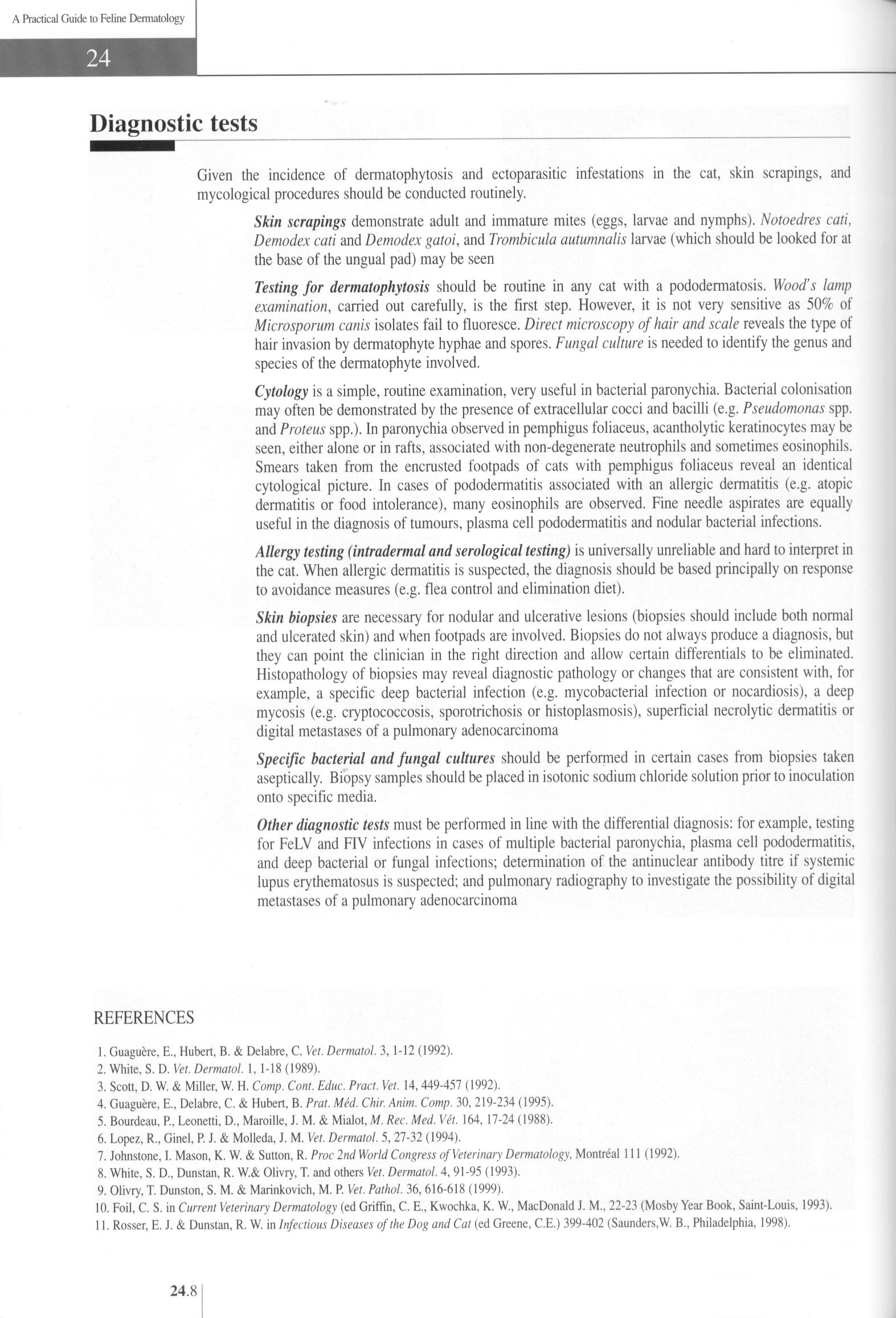248 (22)

24
A Practical Guide to Feline Dermatology
Diagnostic tests
Given the incidence of dermatophytosis and ectoparasitic infestations in the cat, skin scrapings, and mycological procedures should be conducted routinely.
Skin scrapings demonstrate adult and immature mites (eggs, larvae and nymphs). Notoedres cati, Demodex cati and Demodex gatoi, and Trombicula autumnalis larvae (which should be looked for at the base of the ungual pad) may be seen
Testing for dermatophytosis should be routine in any cat with a pododermatosis. Wood’s lamp examination, carried out carefully, is the first step. However, it is not very sensitive as 50% of Microsporum canis isolates fail to fluoresce. Direct microscopy ofhair and scalę reveals the type of hair invasion by dermatophyte hyphae and spores. Fungal culture is needed to identify the genus and species of the dermatophyte involved.
Cytology is a simple, routine examination, very useful in bacterial paronychia. Bacterial colonisation may often be demonstrated by the presence of extracellular cocci and bacilli (e.g. Pseudomonas spp. and Proteus spp.). In paronychia observed in pemphigus foliaceus, acantholytic keratinocytes may be seen, either alone or in rafts, associated with non-degenerate neutrophils and sometimes eosinophils. Smears taken from the encrusted footpads of cats with pemphigus foliaceus reveal an identical cytological picture. In cases of pododermatitis associated with an allergic dermatitis (e.g. atopic dermatitis or food intolerance), many eosinophils are observed. Fine needle aspirates are eąually useful in the diagnosis of tumours, plasma celi pododermatitis and nodular bacterial infections.
Allergy testing (intradermal and serological testing) is universally unreliable and hard to interpret in the cat. When allergic dermatitis is suspected, the diagnosis should be based principally on response to avoidance measures (e.g. flea control and elimination diet).
Skin biopsies are necessary for nodular and ulcerative lesions (biopsies should include both normal and ulcerated skin) and when footpads are involved. Biopsies do not always produce a diagnosis, but they can point the clinician in the right direction and allow certain differentials to be eliminated. Histopathology of biopsies may reveal diagnostic pathology or changes that are consistent with, for example, a specific deep bacterial infection (e.g. mycobacterial infection or nocardiosis), a deep mycosis (e.g. cryptococcosis, sporotrichosis or histoplasmosis), superficial necrolytic dermatitis or digital metastases of a pulmonary adenocarcinoma
Specific bacterial and fungal cultures should be performed in certain cases from biopsies taken aseptically. Biopsy samples should be placed in isotonic sodium chloride solution prior to inoculation onto specific media.
Other diagnostic tests must be performed in linę with the differential diagnosis: for example, testing for FeLV and FIV infections in cases of multiple bacterial paronychia, plasma celi pododermatitis, and deep bacterial or fungal infections; determination of the antinuclear antibody titre if systemie lupus erythematosus is suspected; and pulmonary radiography to investigate the possibility of digital metastases of a pulmonary adenocarcinoma
REFERENCES
1. Guaguere, E., Hubert, B. & Delabre, C. Vet. Dermatol. 3,1-12 (1992).
2. White, S. D. Vet. Dermatol. 1,1-18 (1989).
3. Scott, D. W. & Miller, W. H. Comp. Cont. Educ. Pract. Vet. 14,449-457 (1992).
4. Guaguere, E., Delabre, C. & Hubert, B. Prat. Med. Chir. Anim. Comp. 30, 219-234 (1995).
5. Bourdeau, P., Leonetti, D., Maroille, J. M. & Mialot, M. Rec. Med. Vet. 164,17-24 (1988).
6. Lopez, R., Ginel, P. J. & Molleda, J. M. Vet. Dermatol. 5,27-32 (1994).
7. Johnstone, I. Mason, K. W. & Sutton, R. Proc 2nd World Congress ofVeterinary Dermatology, Montreal 111 (1992).
8. White, S. D., Dunstan, R. W.& 01ivry, T. and others Vet. Dermatol. 4, 91-95 (1993).
9. 01ivry, T. Dunston, S. M. & Marinkovich, M. P. Vet. Pathol. 36, 616-618 (1999).
10. Foil, C. S. in Current Veterinary Dermatology (ed Griffin, C. E., Kwochka, K. W., MacDonald J. M., 22-23 (Mosby Year Book, Saint-Louis, 1993).
11. Rosser, E. J. & Dunstan, R. W. in Infectious Diseases of the Dog and Cat (ed Greene, C.E.) 399-402 (Saunders,W. B., Philadelphia, 1998).
24.8 j
Wyszukiwarka
Podobne podstrony:
22 (503) A Practical Guide to Feline Dermatology ■ 2 Table 2:1: Breed predispositions to common d
234 (22) 23 A Practical Guide to Feline Dermatology autumn, point towards parasitic dermatoses7 such
37 (248) 3 Practical Guide to Feline DermatologyDiagnosis The diagnosis is based on finding these 6
222 (33) 22 A Practical Guide to Feline Dermatology AnimaTs way of life and environment: cats that l
232 (24) 23 A Practical Guide to Feline Dermatology Table 23 : 1 : Aetiology of facial dermatosesINF
236 (22) Practical Guide to Feline Dermatology23 observed on the whole body. Nodular lesions primari
58 (148) 5 A Practical Guide to Feline Dermatology severity of the illness. High titres are seen wit
65 (127) 6 A Practical Guide to Feline Dermatology Other topical antimicrobial agents, such as chlor
67 (125) 6 A Practical Guide to Feline DermatologyNocardiosisAetiopathogenesis Nocardiosis is a very
69 (119) 6 A Practical Guide to Feline DermatologyDiagnosis The diagnosis is based on lesion distrib
710 (2) 7 A Practical Guide to Feline DermatologyHerpesvirus infections Dermatological manifestation
74 (105) 7 A Practical Guide to Feline Dermatology ulcerated. Lesion distribution is multicentric bu
27 A Practical Guide to Feline Dermatology Perianal glands 1.7 Permethrin 3.12, 3.13 Persian 1.6,2.2
27 A Practical Guide to Feline Dermatology Stemphyllium spp. 5.1,7.8 Stereotypie behaviour 17.1,
272 (16) 27 A Practical Guide to Feline Dermatology Alternaria spp. 5.1,7.8 Aluminium hyroxide 15.6&
274 (18) 27 A Practical Guide to Feline Dermatology Colitis 11.2 Collagen 1.2,2.6,12.1,
278 (17) 27 A Practical Guide to Feline Dermatology I J Histoplasmosis 5.8, 7.8, 25.2 Homer’s syndro
28 (374) 2 A Practical Guide to Feline Dermatology Configuration of lesions Determining the configur
313 (14) A Practical Guide to Feline Dermatology The second phase consists of long-term control of t
więcej podobnych podstron